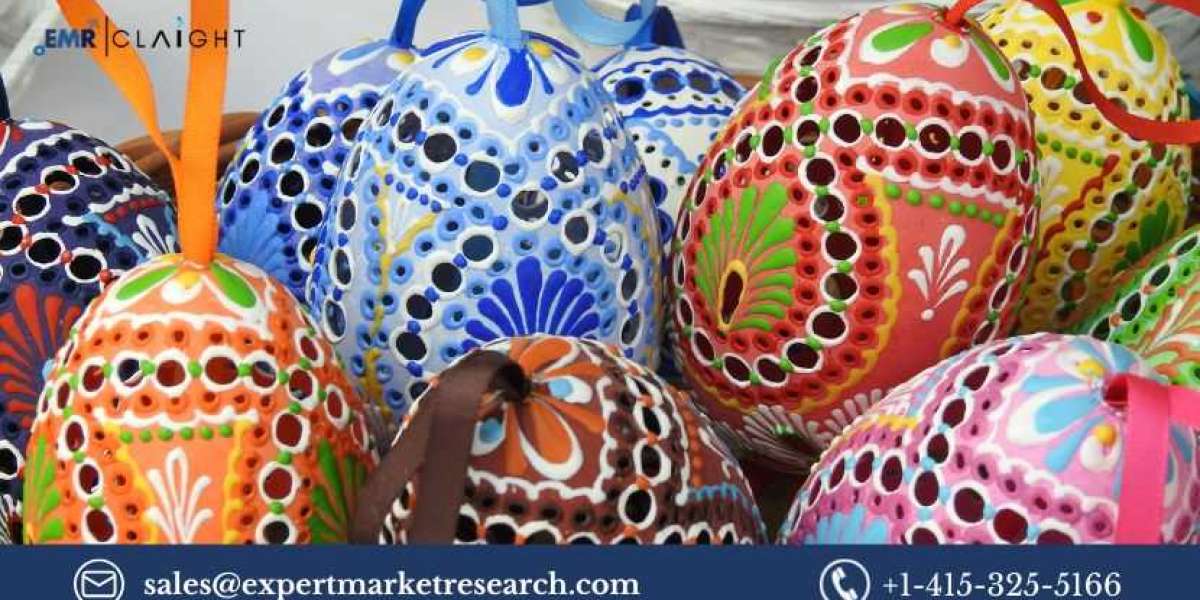The handicrafts market, valued at USD 787.85 billion in 2024, is experiencing a robust growth trajectory, driven by a surge in consumer demand for handmade and artisanal products. The market is projected to grow at a remarkable CAGR of 11.8% from 2025 to 2034, reaching an estimated USD 2,149.93 billion by 2034. This article explores the dynamics, growth factors, market opportunities, and competitive landscape shaping the future of the handicrafts industry.
Overview of the Handicrafts Market
The handicrafts market refers to the production and sale of handmade items such as textiles, pottery, woodcrafts, metalwork, jewellery, and other products crafted using traditional techniques and materials. These products are primarily produced by artisans and small-scale manufacturers, and they cater to both local and international markets. The market has witnessed significant growth in recent years due to the increasing consumer inclination towards unique, sustainable, and culturally rich products.
Key drivers of this growth include the rising preference for eco-friendly goods, increased disposable income, growing awareness of cultural heritage, and the expansion of e-commerce platforms facilitating global trade of handicrafts.
Size of the Handicrafts Market
The global handicrafts market is valued at approximately USD 787.85 billion in 2024. This immense market size reflects a strong demand for unique, custom-made items that appeal to various consumer segments, from home décor enthusiasts to collectors of art. The market is expected to grow at a CAGR of 11.8% over the forecast period from 2025 to 2034. This growth is anticipated to propel the market to a value of USD 2,149.93 billion by 2034.
The market size is driven by multiple factors, including increasing consumer interest in artisanal products, expanding retail channels, and the growth of online marketplaces, where consumers can purchase handicrafts directly from artisans.
Market Share Analysis
The handicrafts market is segmented by product type, region, and sales channel, each contributing to its growing market share:
By Product Type:
- Textiles and Fabrics: The largest segment within the handicrafts market, driven by the popularity of handmade fabrics, tapestries, and embroidered items.
- Woodcrafts: Furniture, sculptures, and decorative items made from wood remain popular due to their aesthetic value and craftsmanship.
- Metalcrafts: Items such as jewellery, sculptures, and kitchenware are significant contributors to the market’s revenue, thanks to the demand for intricate metal works.
- Pottery and Ceramics: Ceramic handicrafts, including pottery and home décor items, are witnessing growing consumer interest due to their artisanal value.
- Jewellery and Beadwork: Handcrafted jewellery continues to capture market share, with consumers seeking one-of-a-kind designs.
By Region:
- Asia-Pacific: This region dominates the global handicrafts market, led by countries such as India, China, and Indonesia, which are known for their rich history of handicraft production.
- North America: The growing appreciation for handmade goods, particularly among millennials and eco-conscious consumers, has boosted demand in the U.S. and Canada.
- Europe: A strong cultural affinity for artisanal products and the growing trend of sustainability has propelled market growth in countries like the UK, France, and Germany.
- Latin America and the Middle East: These regions are seeing steady growth as they embrace local craftsmanship and traditional artistry in response to consumer demand for authenticity and sustainability.
Get a free sample request :- https://www.expertmarketresearch.com/reports/handicrafts-market/requestsample
Market Dynamics and Trends
- Rising Demand for Eco-friendly and Sustainable Products
Sustainability has become a major trend in the global handicrafts market. Consumers are increasingly seeking products that are both eco-friendly and ethically produced. Handicrafts, which are often made from natural materials, align well with the growing demand for sustainable goods, which is a key market dynamic driving growth.
- Growth of E-Commerce Platforms
The rapid growth of e-commerce has revolutionised the handicrafts market. Online marketplaces such as Etsy, Amazon Handmade, and regional platforms have made it easier for artisans to reach global consumers. E-commerce has also allowed consumers to explore a broader variety of handcrafted products, contributing to an increase in market share.
- Cultural and Heritage Appreciation
With increasing interest in culture and heritage preservation, consumers are increasingly gravitating towards products that reflect local traditions and artisanal skills. The desire to support small businesses and traditional artisans has led to an upswing in the handicrafts market, especially in regions with strong cultural and artistic traditions.
- Integration of Modern Designs with Traditional Craftsmanship
Innovative designers are integrating contemporary styles with traditional handicraft techniques. This fusion of old and new has resulted in unique product offerings that cater to a diverse range of consumers, expanding the market and appealing to younger demographics.
Growth Prospects for the Handicrafts Market
The growth potential of the global handicrafts market is substantial. The market is expected to continue expanding due to several key factors:
- Increasing Disposable Income
As the global middle class expands, particularly in emerging economies, more consumers are able to afford luxury items, including handcrafted goods. This growing purchasing power will drive demand for unique, high-quality products.
- Strong Cultural Exports
Countries with a rich tradition of handicraft production, such as India, Morocco, and Mexico, are seeing increased export opportunities, with international demand for their locally produced goods. The appeal of these cultural products in international markets continues to boost the global handicrafts sector.
- Consumer Preference for Personalised and Custom Products
A major trend within the handicrafts market is the growing desire for personalised and bespoke items. Consumers are increasingly drawn to handcrafted goods that reflect their individuality, which is fostering market expansion.
- Collaborations with Designers
Collaborations between traditional artisans and well-known designers are becoming more prevalent, further driving innovation and visibility within the market. These partnerships often result in unique product lines that attract premium buyers.
Market Opportunities and Challenges
Opportunities:
- Rural Employment Growth: The handicrafts market offers significant opportunities to empower rural artisans by providing them with global exposure and the chance to sell their products at a premium.
- Tourism and Souvenir Sales: The travel industry also presents opportunities for the handicrafts market, as souvenirs and locally made crafts are popular among tourists.
- Branding and Storytelling: Artisans and manufacturers can leverage branding and storytelling to differentiate their products in the marketplace, highlighting the cultural significance and craftsmanship behind each item.
Challenges:
- Competition from Mass-Produced Goods: The widespread availability of mass-produced alternatives at lower prices remains a significant challenge for the handicrafts market.
- Pricing Pressures: Handcrafted products often come with a higher price tag due to the time and effort involved in their production, which may deter some price-sensitive consumers.
- Supply Chain and Raw Material Issues: The availability of raw materials can sometimes be inconsistent, which could hinder production capabilities for handicraft manufacturers.
Competitive Analysis
The global handicrafts market is fragmented, with a wide range of small and medium-sized businesses competing in the space. Major players include:
Asian Handicrafts Pvt. Ltd.
Asian Handicrafts Pvt. Ltd. is a prominent player in the handicrafts industry, primarily focused on promoting Indian handicrafts to global markets. The company works closely with artisans across India to produce a wide range of handmade products, including home décor items, textiles, pottery, and jewellery. Known for its commitment to sustainable practices and fair trade, Asian Handicrafts Pvt. Ltd. ensures that its products not only represent India's rich cultural heritage but also support local artisans by offering them fair wages and employment opportunities.
Noah’s Ark International Exports
Noah’s Ark International Exports is another major player in the global handicrafts market, specialising in the export of handcrafted products from India. The company’s portfolio includes a wide range of artisanal goods, such as metal, wood, and stone crafts, as well as home décor items. Noah’s Ark is known for its fair trade practices and strong commitment to sustainable production methods. By working directly with artisans, the company helps preserve traditional crafts while creating economic opportunities for rural communities.
Matr Boomie
Matr Boomie is a US-based company that collaborates with artisans in India to create a diverse collection of handcrafted products, ranging from home décor and accessories to gifts and jewellery. The company’s mission is to empower artisans through fair trade while celebrating traditional craft techniques. Matr Boomie focuses on creating high-quality, socially responsible products and has built a strong online presence, making it a key player in the global handicrafts market.
Novica
Novica is one of the largest online platforms connecting consumers with artisans from around the world. Through partnerships with National Geographic, Novica brings unique, handcrafted products from artisans in over 90 countries to a global audience. The platform focuses on offering fair trade, ethically produced products, and works with artisans to ensure their cultural heritage is preserved. Novica’s expansive marketplace includes jewellery, home décor, fashion, and art.






